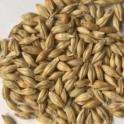DEVELOPMENT

The spring barley ‘UC 933’ is a six-rowed, semidwarf, feed barley which is meant to be sown in the Central Valley and surrounding foothills of California in November or December. UC 933 was released by the California Agricultural Experiment Station in 2001.
BREEDING HISTORY & DEVELOPMENT
The initial parental cross was made by Robert Matchett, who provided subsequent generation seed samples to UC Davis for testing. In the 1992 a single head row was selected by Lynn Gallagher, UCD barley breeder, for agronomic performance and designated as UCD 92-10,585 for preliminary grain yield trials. The next year UCD 92-10,585 was placed into California regional trials and evaluated from 1994 through 2001. The spike of UC 933 is rough awned, mid-dense, waxy and semierect. The hulls are beige with a transparent aleurone (non-blue). Test weight averaged 49.6 lb/bu in 23 trials from 2004 through 2007. Kernel weight averaged about 40.5 mg. Kernels were long(>10mm) and slightly wrinkled with hairs on the ventral furrow. Rachilla hairs are long.
ADAPTATION
UC 933 is an intermediate statured semidwarf averaging 33.9 inches in the trials between 1994 through 2001. It was about one inch shorter than UC 937 and 3 to 4 days earlier to head.
PEST & DISEASE RESISTANCE
For diseases UC 933 is moderately resistant to Barley Yellow dwarf virus, powdery mildew, scald and net blotch races excluding those in the Tehama area. UC 933 is moderately susceptible to leaf rust which usually arrives too late to reduce grain yield. More recently UC 933 has been shown to be highly susceptible to the foliar disease net blotch in Tehama County and is not recommended for growing in that area. In addition UC 933 was resistant to pathotypes of stripe rust commonly found in the Central Valley when the trials were carried out. In two years of testing for resistance to stripe rust at Cochabamba, Bolivia, UC 933 was scored as ‘trace resistant and 5% moderately susceptible” compared to 100% susceptible and 90% susceptible for ‘UC 828’.
YIELD DATA
In grain yield tests (15 trials) in the San Joaquin Valley, UC 933 averaged 5,317 lb/acre which was 8% more than ‘UC 937’. In the Sacramento Valley (13 trials), UC 933 averaged 5,228 lb/acre which was 16% more than UC 937. In lower yielding rainfed environments (16 trials) UC 933 averaged 2,886 lb/acre which was 14% more than UC 937. Subsequent to the release of UC 933, grain yield trials continued to compare UC 933 with more recently developed varieties. From 2004 through 2007 in 26 California trials averaged over three macro-environments (Sac. Valley, San Joaquin Valley and rainfed), UC 933 yields averaged 4,194 lb/acre compared the following varieties and yields: UC 937 about 3,958 lb/acre, ‘UC 969’ ( earliest heading with highest hulled test weight) 3,852 lb/acre, Ishi (aka UC 1047) 4,328 lb/acre, and ‘Tamalpais’ (aka UC 1134, the naked grained or hulless barely with very high test weight) 4,022 lb/acre.